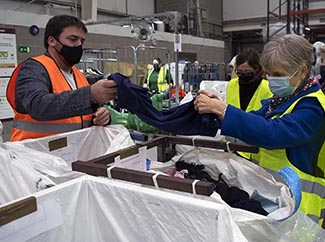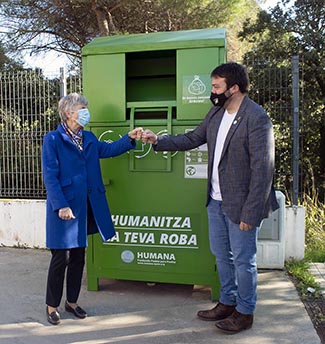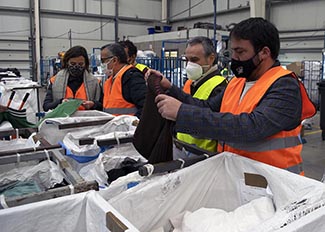consent_cookie
Duración: 1 year
Stores the user's cookie consent state
26-11-2021
"The management of textile waste is a very important challenge, even more so in a paradigm of circular economy." This was stated this morning by the director of the Catalan Waste Agency (ARC), Isaac Peraire, after visiting our textile preparation plant for reuse, in l'Ametlla del Vallès (Barcelona).
Peraire has toured the facility accompanied by the director of the ARC's Circular Economy area, Pilar Chiva; the head of the Waste Prevention and Efficiency Department, Alfred Vara, and the mayor of l'Ametlla del Vallès, Pep Moret. They have been guided by the general director of Humana, Elisabeth Molnar, who has highlighted the environmental benefit of reuse and the contribution of used clothing management to the circular economy. This visit coincides with the final stretch of the European Week for Waste Prevention, which takes place from 22 to 28 November.
The director of the ARC has assured: “Humana is an important agent that manages a fundamental waste. This work must be valued and that is why I am happy to get to know it closely, as well as the circuit that clothes follow. I wanted to know what happens with this residue that stops being it, thanks to the work of entities like Humana. And even more so on a day like today, which is Black Friday; a week like this, the European Week for Waste Prevention, and with the Christmas campaign on the doorstep ”.
"The importance of textile waste management is a major challenge," he added, "in the landfill there is still a lot of textile waste that could have been greatly reduced with responsible consumption and depositing it in the appropriate containers for careful collection. selective ”.
Pact for Circular Fashion
According to Isaac Peraire, “the percentage of selective collection is very low but the positive part is that we know what must be done to improve it and we have set about it: from the Agency we are working intensively on the Pact for Circular Fashion, key in this ambit; there will be news in the legislative field, which will have to address this issue; and it is necessary to vindicate the extended responsibility of the producer, which must be fundamental. In the same way, administrations, entities and citizens have to influence explaining what happens to the clothes when we give them, that they have confidence in the subsequent management ”.
For her part, Humana CEO Elisabeth Molnar stated: “Our work in the reused textile sector is essential in the transition to a circular textile industry. Our framework for action is the waste hierarchy established by the European Union, which prioritizes the prevention and reuse of waste over recycling ”. She has defended that "reuse has enormous benefits, not only in environmental terms but also in the creation of green occupation". And she added: "60% of the clothing purchased from Humana's second-hand stores replaces the acquisition of new parts, which contributes to the prevention of CO₂ emissions and subsequent textile waste."
5,000 tons recovered each year in Catalonia
The l'Ametlla del Vallès preparation for reuse plant receives the textile waste that Humana recovers in Catalonia (an average of 5,000 tons per year). It has an area of 2,000 m², 20 tons of used clothing are processed daily (1.2 tons daily for each sorting person) and it has a team of 36 people.
Humana has 1,500 containers for the collection of clothes in Catalonia thanks to the agreements, contracts and agreements established with city councils, entities and private companies. Thousands of donors, when checking the closet, deposit the clothing, footwear, accessories and home textiles that they no longer use in the Foundation's green containers.
Textile waste has become a global problem. The consumption of clothing has grown rapidly and its useful life is getting shorter and shorter. In Catalonia, 165,933 tons of textile waste are generated, according to 2020 data from the ARC. Each citizen throws away 21.6 kilos of clothes annually, on average.
Even so, selective collection by authorized managers only represents 10.6% of total textile waste from household consumption. The rest goes to the rest fraction, therefore, it ends up in a landfill or an incinerator.
Faced with this scenario, the Pact for Circular Textile Fashion in Catalonia has been created, which brings together the different agents of the textile sector and wants to respond to the challenges of sustainable development in this area. It is promoted by the Generalitat, with representatives of the sector's value chain and other administrations and technology and research centers.


